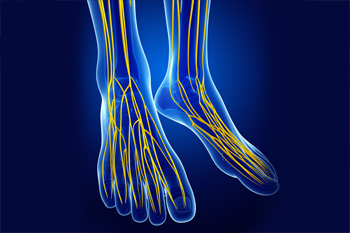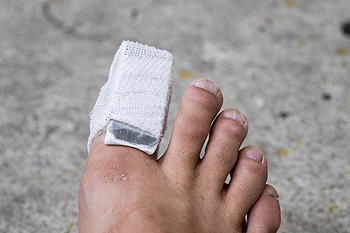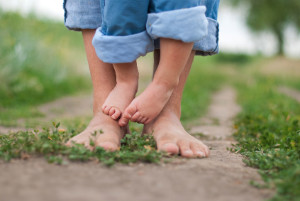Items filtered by date: December 2019
First Pair of Shoes
The majority of babies are born with flexible and flat feet, as a result of underdeveloped bones which will be fully formed as the feet get stronger. This typically occurs during the teenage years. Research has indicated that it is beneficial for toddlers to walk barefoot while indoors. This can help the feet to build strength as the toes grasp the floor. When it is time for the first pair of shoes to be purchased, it is beneficial to look for materials that are flexible, in addition to being able to provide adequate support. If you notice your child walks with their feet pointed inward or outward, it is suggested that you speak to a podiatrist, who can prescribe insoles that are designed for your child.
The health of a child’s feet is vital to their overall well-being. If you have any questions regarding foot health, contact one of our podiatrists of Carolina Foot & Ankle. Our doctors can provide the care you need to keep you pain-free and on your feet.
Tips for Keeping Children's Feet Healthy
- Make sure their shoes fit properly
- Look for any signs of in-toeing or out-toeing
- Check to see if they have Clubfoot (condition that affects your child’s foot and ankle, twisting the heel and toes inward) which is one of the most common nonmajor birth defects.
- Lightly cover your baby’s feet (Tight covers may keep your baby from moving their feet freely, and could prevent normal development)
- Allow your toddler to go shoeless (Shoes can be restricting for a young child’s foot)
- Cut toenails straight across to avoid ingrown toenails
- Keep your child’s foot clean and dry
- Cover cuts and scrapes. Wash any scratches with soap and water and cover them with a bandage until they’ve healed.
If you have any questions, please feel free to contact one of our offices located in Huntersville Office | 16419 Northcross Dr Suite A, Huntersville, NC 28078; Mooresvillle Office | 206 Joe Knox Avenue Suite D, Mooresville, NC 28117; and Mountain Island | 10310 Couloak Drive Suite 200, Charlotte, NC 28216 . We offer the newest diagnostic and treatment technologies for all your foot care needs.
Who Is Prone To Developing Heel Spurs?
 Severe pain in the heel may be indicative of a heel spur. This condition can develop as a result of the aging process, or from participating in running and jumping activities. Additionally, patients who wear shoes that do not fit correctly, are overweight, or have endured an injury to the heel may be candidates for heel spurs. Some of the symptoms that are associated with this condition can consist of redness, tenderness, and an achy feeling in the heel and surrounding area. It may appear swollen and cause difficulty in walking. Many patients have found moderate relief when the feet are elevated, and shoes that are worn have adequate cushioning. If you feel you may have a heel spur, it is advised that you seek the counsel of a podiatrist who can properly treat this condition.
Severe pain in the heel may be indicative of a heel spur. This condition can develop as a result of the aging process, or from participating in running and jumping activities. Additionally, patients who wear shoes that do not fit correctly, are overweight, or have endured an injury to the heel may be candidates for heel spurs. Some of the symptoms that are associated with this condition can consist of redness, tenderness, and an achy feeling in the heel and surrounding area. It may appear swollen and cause difficulty in walking. Many patients have found moderate relief when the feet are elevated, and shoes that are worn have adequate cushioning. If you feel you may have a heel spur, it is advised that you seek the counsel of a podiatrist who can properly treat this condition.
Heel spurs can be incredibly painful and sometimes may make you unable to participate in physical activities. To get medical care for your heel spurs, contact one of our podiatrists from Carolina Foot & Ankle. Our doctors will do everything possible to treat your condition.
Heels Spurs
Heel spurs are formed by calcium deposits on the back of the foot where the heel is. This can also be caused by small fragments of bone breaking off one section of the foot, attaching onto the back of the foot. Heel spurs can also be bone growth on the back of the foot and may grow in the direction of the arch of the foot.
Older individuals usually suffer from heel spurs and pain sometimes intensifies with age. One of the main condition's spurs are related to is plantar fasciitis.
Pain
The pain associated with spurs is often because of weight placed on the feet. When someone is walking, their entire weight is concentrated on the feet. Bone spurs then have the tendency to affect other bones and tissues around the foot. As the pain continues, the feet will become tender and sensitive over time.
Treatments
There are many ways to treat heel spurs. If one is suffering from heel spurs in conjunction with pain, there are several methods for healing. Medication, surgery, and herbal care are some options.
If you have any questions feel free to contact one of our offices located in Huntersville Office | 16419 Northcross Dr Suite A, Huntersville, NC 28078; Mooresvillle Office | 206 Joe Knox Avenue Suite D, Mooresville, NC 28117; and Mountain Island | 10310 Couloak Drive Suite 200, Charlotte, NC 28216 . We offer the latest in diagnostic and treatment technology to meet your needs.
What Can Cause Poor Foot Circulation?
 Poor circulation in the feet occurs when the body is unable to carry sufficient amounts of blood to the area. It typically occurs as a result of blocked arteries and can cause severe pain and discomfort. The symptoms that are associated with poor circulation can include numbness, tingling, foot cramps, and difficulty walking. Some patients experience visible symptoms that may consist of dry skin, swollen feet, and the toes may appear discolored. In addition to blocked arteries, there may be other reasons that may cause poor circulation. These may include smoking, standing or sitting for extended periods of time, and eating unhealthy foods. Relief may be found when the feet are frequently elevated and if a gentle exercise regime is incorporated into your daily routine.
Poor circulation in the feet occurs when the body is unable to carry sufficient amounts of blood to the area. It typically occurs as a result of blocked arteries and can cause severe pain and discomfort. The symptoms that are associated with poor circulation can include numbness, tingling, foot cramps, and difficulty walking. Some patients experience visible symptoms that may consist of dry skin, swollen feet, and the toes may appear discolored. In addition to blocked arteries, there may be other reasons that may cause poor circulation. These may include smoking, standing or sitting for extended periods of time, and eating unhealthy foods. Relief may be found when the feet are frequently elevated and if a gentle exercise regime is incorporated into your daily routine.
Poor circulation is a serious condition and needs immediate medical attention. If you have any concerns with poor circulation in your feet contact one of our podiatrists of Carolina Foot & Ankle. Our doctors will treat your foot and ankle needs.
Poor Circulation in the Feet
Poor blood circulation in the feet and legs is can be caused by peripheral artery disease (PAD), which is the result of a buildup of plaque in the arteries.
Plaque buildup or atherosclerosis results from excess calcium and cholesterol in the bloodstream. This can restrict the amount of blood which can flow through the arteries. Poor blood circulation in the feet and legs are sometimes caused by inflammation in the blood vessels, known as vasculitis.
Causes
Lack of oxygen and oxygen from poor blood circulation restricts muscle growth and development. It can also cause:
- Muscle pain, stiffness, or weakness
- Numbness or cramping in the legs
- Skin discoloration
- Slower nail & hair growth
- Erectile dysfunction
Those who have diabetes or smoke are at greatest risk for poor circulation, as are those who are over 50. If you have poor circulation in the feet and legs it may be caused by PAD and is important to make changes to your lifestyle in order to reduce risk of getting a heart attack or stroke. Exercise and maintaining a healthy lifestyle will dramatically improve conditions.
As always, see a podiatrist as he or she will assist in finding a regimen that suits you. A podiatrist can also prescribe you any needed medication.
If you have any questions please feel free to contact one of our offices located in Huntersville Office | 16419 Northcross Dr Suite A, Huntersville, NC 28078; Mooresvillle Office | 206 Joe Knox Avenue Suite D, Mooresville, NC 28117; and Mountain Island | 10310 Couloak Drive Suite 200, Charlotte, NC 28216 . We offer the newest diagnostic and treatment technologies for all your foot and ankle needs.
Exercising and Broken Toes
 An effective method of possibly finding relief from a broken toe is referred to as buddy taping. This process involves taping the affected toe to the toe next to it, which helps to provide adequate support as the toe heals. In the days following the injury that caused the fracture, it is important to elevate the foot as often as possible. Elevating the foot may be helpful in reducing any existing swelling. People who frequently engage in cardiovascular exercise may have to choose activities that are low impact. These types of exercises can include swimming and cycling, and are generally effective in keeping the weight off of the toes. If you are experiencing pain from a broken toe while exercising, it is suggested that you speak to a podiatrist who can provide you with additional exercise options.
An effective method of possibly finding relief from a broken toe is referred to as buddy taping. This process involves taping the affected toe to the toe next to it, which helps to provide adequate support as the toe heals. In the days following the injury that caused the fracture, it is important to elevate the foot as often as possible. Elevating the foot may be helpful in reducing any existing swelling. People who frequently engage in cardiovascular exercise may have to choose activities that are low impact. These types of exercises can include swimming and cycling, and are generally effective in keeping the weight off of the toes. If you are experiencing pain from a broken toe while exercising, it is suggested that you speak to a podiatrist who can provide you with additional exercise options.
A broken toe can be very painful and lead to complications if not properly fixed. If you have any concerns about your feet, contact one of our podiatrists from Carolina Foot & Ankle. Our doctors will treat your foot and ankle needs.
What to Know About a Broken Toe
Although most people try to avoid foot trauma such as banging, stubbing, or dropping heavy objects on their feet, the unfortunate fact is that it is a common occurrence. Given the fact that toes are positioned in front of the feet, they typically sustain the brunt of such trauma. When trauma occurs to a toe, the result can be a painful break (fracture).
Symptoms of a Broken Toe
- Throbbing pain
- Swelling
- Bruising on the skin and toenail
- The inability to move the toe
- Toe appears crooked or disfigured
- Tingling or numbness in the toe
Generally, it is best to stay off of the injured toe with the affected foot elevated.
Severe toe fractures may be treated with a splint, cast, and in some cases, minor surgery. Due to its position and the pressure it endures with daily activity, future complications can occur if the big toe is not properly treated.
If you have any questions please feel free to contact one of our offices located in Huntersville Office | 16419 Northcross Dr Suite A, Huntersville, NC 28078; Mooresvillle Office | 206 Joe Knox Avenue Suite D, Mooresville, NC 28117; and Mountain Island | 10310 Couloak Drive Suite 200, Charlotte, NC 28216 . We offer the newest diagnostic and treatment technologies for all your foot and ankle needs.


